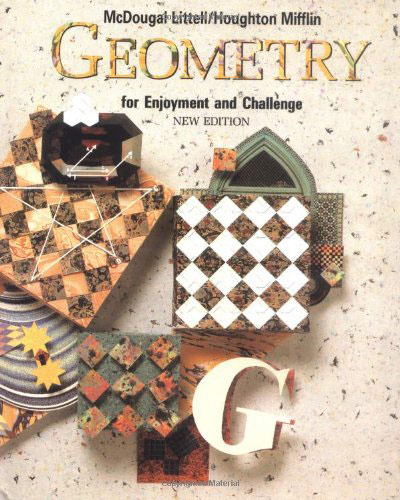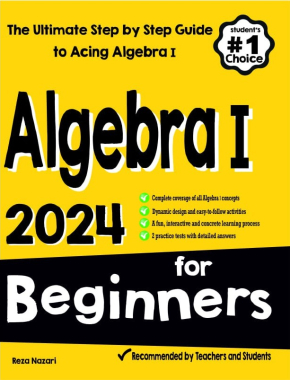Top 10 Geometry Books for High School Students
In the wise words of Galileo, "Mathematics is the alphabet with which God has written the universe." This profound statement illuminates the importance of mathematics in deciphering the natural world and the universe's grand design. Among the mathematical "letters" Galileo refers to, geometry holds a particularly unique and essential place. It serves as a powerful tool that allows us to comprehend and interpret the spatial aspects of our surroundings. Indeed, it is geometry that provides the basis for us to understand everything from the shape of a leaf to the layout of a city, from the structure of a molecule to the movement of celestial bodies.

As we navigate the intricate field of geometry, we come across a vast array of resources, each claiming to be the key to unlocking the subject’s mysteries. To help you through this maze, this article will explore the top 10 geometry books for high school students. Our aim is to provide a comprehensive and practical guide for those embarking on their geometry journey, guiding you to resources that will make the subject both comprehensible and fascinating.
The Absolute Best Book to Ace Geometry
The Unparalleled Importance of Geometry in High School
Decoding the Role of Geometry in Education
“Why is geometry so critical, especially at the high school level?” you may find yourself wondering. At first glance, geometry might seem to be all about shapes – circles, squares, triangles, and so forth. However, a deeper look reveals it to be a field that goes far beyond these rudimentary elements.
Geometry is fundamentally an exploration of the spatial relationships between different figures and forms. It’s about understanding how shapes interact with each other and the space they inhabit. Moreover, it aids in developing the foundational reasoning and problem-solving skills that are not just critical for more advanced mathematical studies but are also vital across a multitude of other disciplines such as physics, engineering, computer science, and even philosophy.
The Far-reaching Benefits of Learning Geometry
But the value of learning geometry doesn’t stop at the development of critical thinking and problem-solving skills. Another immense benefit of geometry is how it allows students to understand, interpret, and appreciate the world around them.
Take a moment to look around you – notice how geometric principles come to life. The artistic symmetries in a painting, the precise angles, and proportions of architectural marvels, the laws of physics governing everything from light to gravity, and even the polygons rendering your favorite video game on the computer screen – all of these are applications of geometry. By studying geometry, students learn to see the world through a unique lens, fostering an understanding and appreciation of the geometric principles that underpin our daily lives.
Key Factors to Consider When Choosing a Geometry Book
Venturing into the study of geometry might feel like standing at the foot of a grand mountain, unsure of the best path to reach the summit. It’s a vast subject, and the choice of the right guidebook, in this case, a geometry textbook, can dramatically affect your journey. Choosing the right geometry book can indeed be a daunting task, given the plethora of options available. However, this process becomes simpler when you consider certain factors that would match your unique needs and preferences.
Unearthing Your Learning Style
First and foremost, it’s important to understand that everyone learns differently. There’s no one-size-fits-all approach to learning, and this holds especially true for a complex subject like geometry. Some people are visual learners, preferring diagrams, illustrations, and other graphic representations to explain concepts. For them, a geometry book rich in visuals and less dense in textual content would be more beneficial.
On the other hand, some people prefer a more theoretical approach. They thrive on detailed written explanations and thrive on the logical structure of proofs and theorems. If you identify with this style, a geometry book that delves deep into theoretical explanations and provides comprehensive written content would serve you well.
Recognizing your individual learning style is a critical first step in choosing a geometry book. The most effective book will align closely with your learning preferences, ensuring the material is presented in a way that you can easily digest, comprehend, and apply.
Ensuring Content Comprehensiveness
Another crucial factor to consider when choosing a geometry book is the comprehensiveness of its content. Geometry is a wide-ranging subject, encompassing everything from basic shapes and properties to complex spatial relations, theorems, and proofs.
A good geometry book should provide a thorough and complete exploration of these concepts. It should start with basic principles and progressively guide you toward more advanced topics, facilitating a deep understanding of the subject. In other words, it should be a reliable and comprehensive resource that you can lean on throughout your geometric studies, a dependable companion on your journey from the foothills to the summit of your understanding.
The best books explain concepts clearly and concisely, provide examples, and offer exercises to help you practice and solidify your understanding. Remember, the goal isn’t just to get through the book, but to understand and retain the knowledge it imparts. So, choose a geometry book that serves as a clear, detailed, and comprehensive guide, pushing your comprehension of the subject ever forward.
Assessing the Book’s Structure and Layout
The way a book is structured can significantly impact your learning experience. A well-structured book logically organizes the content, gradually moving from simple to complex concepts. This step-by-step progression allows you to build upon what you’ve learned, enhancing your comprehension and retention of the subject matter.
Additionally, the layout of the book, including the readability of the text, the clarity of diagrams, and the organization of the chapters, can make a big difference. A clean and intuitive layout makes it easy to follow along and keep track of where you are in your studies.
Reviewing the Quality of Exercises and Practice Problems
Geometry, like any branch of mathematics, requires practice to master. The best geometry books include a variety of exercises and practice problems at the end of each chapter or section. These problems allow you to apply what you’ve learned and reinforce your understanding.
Moreover, the quality of these exercises matters a great deal. They should span a range of difficulty levels, from simple problems that test your understanding of basic concepts to more challenging ones that encourage critical thinking and problem-solving skills.
Checking the Availability of Answer Keys and Solutions
While practicing problems is essential, it’s equally important to have a way to check your work. Geometry books that include answer keys and worked-out solutions to exercises can be tremendously helpful. They not only allow you to verify your answers but also provide insight into how to approach and solve problems. If you get stuck, these solutions can guide you step-by-step through the problem, enhancing your understanding and problem-solving abilities.
Considering the Book’s Relevance to Your Coursework
Finally, it’s crucial to consider how well the book aligns with your coursework. If you’re selecting a geometry book for independent study, this may not be as important. However, if you’re using the book to supplement a high school geometry course, ensure the book covers the topics outlined in your curriculum. Furthermore, the book should adhere to the standards set by educational authorities, ensuring you’re learning geometry as it’s universally understood and applied.
Remember, the ultimate goal is to find a book that matches your needs and preferences, serving as a useful guide throughout your geometry learning journey. Take your time and choose wisely – the right book can make all the difference.
The Best Algebra Prep Resource
10 Best Geometry Books for High School Students: Essential Guides to Navigating the Geometric Landscape
Geometry is a vast field, and navigating it can feel daunting. However, with the right resources, the journey can be exciting, enlightening, and ultimately, immensely rewarding. Here, we present our top 10 picks for geometry books for high school students, each bringing unique strengths to light up the path to mastering this intricate subject.
1: Geometry for Beginners: The Ultimate Step by Step Guide to Acing Geometry
We begin our list with a comprehensive Geometry book. A mainstay in high school geometry education, this book is beloved for its clear, concise explanations and comprehensive content coverage. The author’s approach brings a methodical progression from basic to advanced concepts, making it an excellent guide for students seeking to deepen their geometric understanding.
2: “Geometry: Seeing, Doing, Understanding” by Harold R. Jacobs
Visual learners, rejoice! Harold R. Jacobs’ “Geometry: Seeing, Doing, Understanding” is an innovative book that makes excellent use of diagrams and real-world examples to illuminate geometric principles. Jacobs’ unique approach brings geometry to life, making abstract concepts tangible and easy to grasp.
3: “Geometry for Enjoyment and Challenge” by Richard Rhoad
Richard Rhoad’s “Geometry for Enjoyment and Challenge” goes beyond simply teaching geometry to foster a genuine appreciation for the subject. This book features engaging and thought-provoking exercises that not only test understanding but also ignite curiosity. If you’re looking for a book that challenges you to think deeply about geometry, this one is a strong contender.
4: “Barron’s Painless Geometry” by Lynette Long
Touted as a delight to read, “Barron’s Painless Geometry” by Lynette Long aims to make learning geometry an enjoyable process. The book’s engaging style, fun illustrations, and real-world applications make it a great option for those who appreciate a less traditional, more relaxed approach to studying.
5: “Geometry: A High School Course” by Serge Lang and Gene Murrow
Serge Lang and Gene Murrow’s “Geometry: A High School Course” stands out for its structured and methodical approach. The book guides students through a systematic, step-by-step journey through geometry, making it an excellent resource for those who appreciate a logically organized learning process.
6: “Geometry: Concepts and Skills” by Ron Larson
Striking a perfect balance between theory and practice, “Geometry: Concepts and Skills” by Ron Larson is another top pick. Known for its wealth of problems spanning a range of difficulty levels, this book provides ample opportunity to apply and solidify understanding, making it an invaluable tool for mastering geometry.
7: “McGraw-Hill’s Geometry Workbook”
“McGraw-Hill’s Geometry Workbook” serves as a practical supplement to any high school geometry course. Overflowing with exercises designed to reinforce geometric concepts, this workbook is a perfect companion for students seeking additional practice to cement their knowledge.
8: “Geometry by Construction” by Michael McDaniel
If you’re intrigued by a hands-on approach to learning, “Geometry by Construction” by Michael McDaniel might be just the book for you. It introduces geometric concepts through the ancient art of geometric construction, giving you a tactile and visual understanding of the subject matter.
9: “Geometry, Relativity and the Fourth Dimension” by Rudy Rucker
For those with an adventurous spirit looking to delve into the more abstract corners of geometry, Rudy Rucker’s “Geometry, Relativity and the Fourth Dimension” could be a perfect match. This book offers fascinating insights into the world of fourth-dimensional geometry, stretching the boundaries of traditional geometric study.
10: “Euclid’s Elements”
No geometry book list would be complete without the seminal work of Euclid: “Elements“. While the language may be antiquated, the geometric principles Euclid laid out over two millennia ago remain as relevant as ever. This foundational text of geometric theory provides a glimpse into the roots of geometry, reminding us of the enduring nature of these universal truths.
These are our top 10 picks for geometry books for high school students. Each offers a unique approach to mastering this complex field, catering to various learning styles and preferences. With these resources at your fingertips, your journey into the world of geometry promises to be both enriching and engaging. Happy studying!
Final Words: Embrace the Beauty of Geometry
So there you have it – a comprehensive guide to the top 10 geometry books for high school students. Geometry, with its intriguing blend of abstract and concrete elements, is a captivating subject that provides vital skills for understanding the spatial dimensions of our world. The right book can transform the learning process, turning it into an enjoyable and effective journey of discovery.
Remember that learning is not a race but a personal journey. Each book on this list has its strengths, so choose the one that best aligns with your learning style and needs. No matter your choice, each book will serve as a reliable compass guiding you through the intricate landscape of geometry. So grab your protractor, your compass, and a good book, and set off on your geometric adventure. Happy studying!
Frequently Asked Questions
In this final section, we address some common questions about these top 10 geometry books for high school students.
Q: Are all these books suitable for beginners?
A: Most of the books on this list cater to beginners, providing clear and understandable introductions to fundamental concepts. However, some books, like “Geometry, Relativity, and the Fourth Dimension,” delve into more complex areas and might be more challenging for beginners. It’s important to select a book that matches your current understanding and learning goals.
Q: Can I use these books for self-study?
A: Absolutely! Many of these books are designed with self-study in mind, providing comprehensive explanations, step-by-step guides, and ample practice problems. They serve as excellent resources for students seeking to learn geometry independently.
Q: Are these books available in digital format?
A: Many of the books on this list are available in both print and digital formats. The availability might vary depending on the publisher and the platform from which you’re purchasing.
Q: Is “Euclid’s Elements” too outdated for modern geometry?
A: While the language in “Euclid’s Elements” is antiquated, the principles it outlines form the bedrock of geometry. This text provides a historical and foundational understanding of the subject, which can be valuable despite the evolution of geometric study over the centuries.
Q: Do these books include exercises and solutions?
A: Yes, most of the books on this list feature a variety of exercises along with detailed solutions. This setup allows students to apply the concepts they’ve learned and then verify their answers, ensuring a comprehensive understanding of geometric principles.
The Best Algebra Prep Resource
Related to This Article
More math articles
- FREE HiSET Math Practice Test
- Math Café: How to Learn the Art of Writing and Solving Two-variable Equations
- The Ultimate Ready to Work Algebra 1 Course (+FREE Worksheets)
- TSI Math FREE Sample Practice Questions
- 6th Grade IAR Math Worksheets: FREE & Printable
- 10 Most Common 8th Grade STAAR Math Questions
- How to Understand Vocabulary of Financial Institutions
- Equation of Each Ellipse and Finding the Foci, Vertices, and Co– Vertices of Ellipses
- 10 Most Common 8th Grade Georgia Milestones Assessment System Math Questions
- Math Mastery: Effortless Math Learning

























What people say about "Top 10 Geometry Books for High School Students - Effortless Math: We Help Students Learn to LOVE Mathematics"?
No one replied yet.